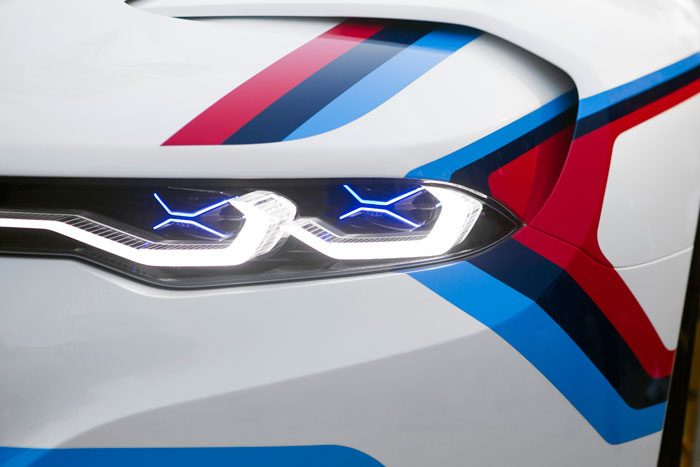BMW has announced the world premiere of the BMW 3.0 CSL Hommage R – a car that celebrates both the 40th anniversary of BMW in North America and the heady racing success of the BMW 3.0 CSL in 1975.

That was the year the Bavarian manufacturer founded BMW of North America – its first official sales company outside Europe. It was also the year in which BMW Motorsport made its debut in motor racing stateside – in the IMSA series – with a specially made BMW 3.0 CSL. Just a few weeks later BMW recorded its first triumph at the 12 Hours of Sebring. This was followed by a succession of victories, including one at Laguna Seca.
BMW’s rookie year duly culminated in the white BMW 3.0 CSL, decked out in eye-catching BMW Motorsport livery, winning the manufacturers’ championship at the first attempt. This success, coupled with the car’s striking design and the “Bavarian Motor Works” legend emblazoned across the sun protection film on the windscreen and rear window, announced the BMW brand’s arrival in racing-mad North America with a bang.
In the BMW 3.0 CSL Hommage R, the idea of centring attention on the driver begins with his immediate surroundings. This new approach led the designers first to the driver’s helmet, race suit and seat before moving on to the lines and surfaces of the interior.
This way of doing things changes the nature of conventional interior functions. As the layer of interaction closest to the driver, the helmet visor assumes the functions of a display and projects situation-based information, such as the car’s speed, gear engaged and engine revs into the driver’s direct field of view. The BMW 3.0 CSL Hommage R thus enhances the driver’s direct perception.
As well as helping him to do his job, the driver’s race suit visually expresses the connection between the driver and the car. If both the driver’s hands are on the steering wheel, illuminated piping integrated into the sleeves of the suit shows the progress of information – from the shift impulse display, for example – out of the steering column over the driver’s arms and into his visor.
The side-section design of the large carbon-fibre seat shells reflects the anatomy of the seated driver, thus providing maximum support in any driving situation. At the same time, the seats ensure the driver’s body has the best possible connection with the car, giving him a physical feel for it with almost his whole body, in any situation, and thus allowing him to react faster and more effectively.
The seat shells follow a rising diagonal path rearwards, a line extended behind the seats into the rear by a structural carbon-fibre element that increases the torsional rigidity of the BMW 3.0 CSL Hommage R. The white seat surfaces with fanned-out quilting, integrated into the seat shell, mimic the design of the driver’s race suit, while BMW Motorsport’s signature stripes on the six-point safety harness add an extra splash of colour.
A carbon-fibre roll cage integrated into the structure of the car’s roof and side sections forms the basis for an interior made almost entirely from carbon fibre, the only wood-like presence is the “instrument panel” – actually a cross-member and purely structural element.
The commitment to paring the car down to the bare essentials places particular emphasis on the steering column. As a mechanical link between the driver and car, it is home to all the operating elements and controls. The only “comfort” function are the two vents on the sides of the steering column, which supply the driver with fresh air at ambient temperature.
A small display on the steering column provides the driver with secondary information, such as lap times, overall race time and the car’s current track position, as required. Other racing elements in the interior include red anodised safety features, such as the outlet nozzles for the fire extinguishing foam, the extinguisher itself, and the two switches on the centre console for the emergency shut-off and fire extinguishing mechanism.
“It represents the heartbeat of BMW. Back in 1975, as today, winning races came down to how man and machine could work together,” explains Adrian van Hooydonk, senior vice-president of BMW Group Design.









